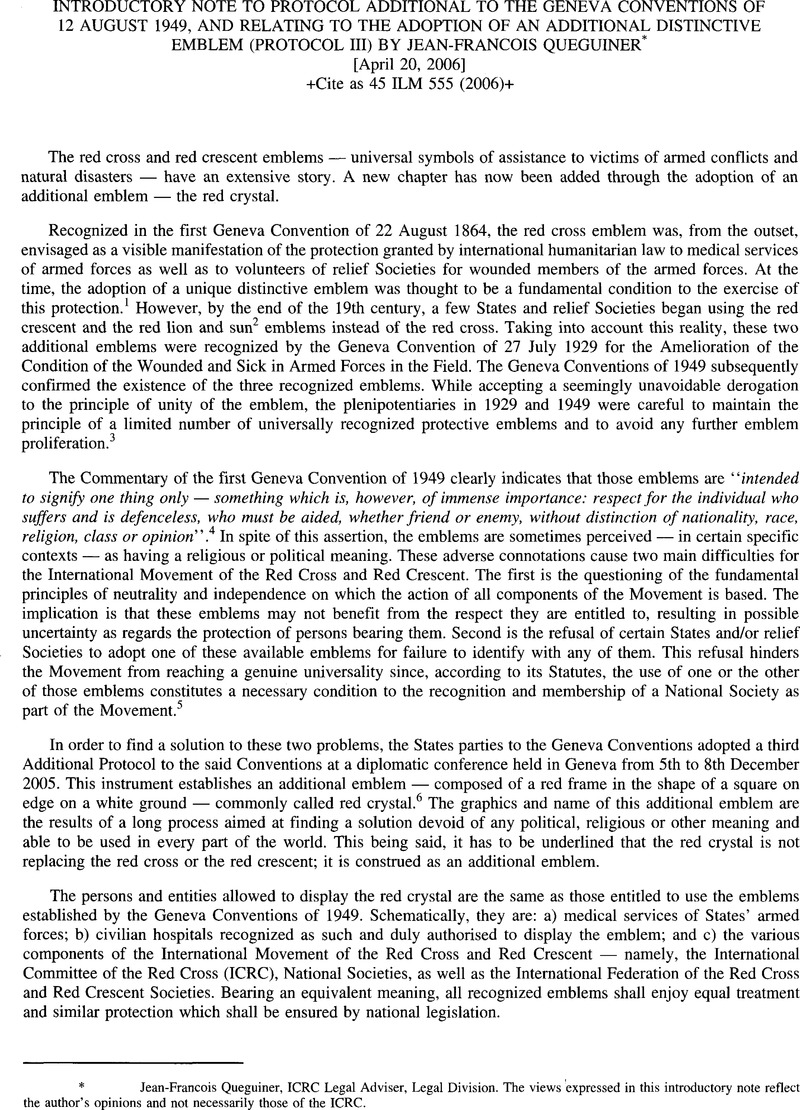Published online by Cambridge University Press: 27 February 2017

1 “Long before the Red Cross was founded, hospitals and ambulances were sometimes marked on the battlefield by a flag of a single colour, which varied according to the occasion and the country. From the beginning, those responsible for the Red Cross and the Geneva Convention recognized the need for a uniform international emblem as the visible sign of the immunity to which medical personnel and the wounded should be entitled” (emphasis added); Commentary Geneva Convention I, Art. 38, ICRC, 1952, p. 297.
2 The Islamic Republic of Iran — the only State having used the red lion and sun emblem — has now abandoned its use.
3 For a more detailed historical background on the emblem issue, see in particular Bugnion, F.,’ ‘Toward a comprehensive solution to the question of the emblem”, Revised Fourth edition, online <http://www.gva.icrc.priv/Web/Eng/siteeng0.nsf/iwpList91/FD75C6E624074653C1256DE1003FBlD0>;, pp. 5-23.
4 Commentary of Article 38 of the Geneva Convention (I) for the Amelioration of the Condition of Wounded and Sick in Armies in the Field, 1958, p. 305.
5 “Conditions for recognition of National Societies”, Article 4 of the Statutes of the Movement, indeed stipulates that ‘ ‘In order to be recognized in terms of Article 5, paragraph 2 b) as a National Society, the Society shall meet the following conditions: […] 5. Use the name and emblem of the Red Cross or Red Crescent in conformity with the Geneva Conventions''.
6 The additional emblem ‘ ‘is referred to in [the third additional] Protocol as the ‘third Protocol emblem'''. However, regarding this issue, paragraph 14 of the Final Act states that: “Although Protocol III referred to the additional emblem as the ‘third Protocol emblem', the ICRC and the IFRC informed the Con-ference that the designation ‘red crystal’ had gained currency and would be introduced formally at the next International Conference of the Red Cross and Red Crescent”.
7 At least since 1930, the Israeli relief society of Magen David Adorn uses the red shield of David. This emblem has been the object of a communication, when Israel, at the time of depositing its ratification instrument on the 6th of July 1951 submitted, through the depository, its reservation to the High Contracting parties and to the ICRC. This reservation indicates that: ‘ ‘while respecting the inviolability of the distinctive signs and emblems of the Convention, Israel will use the Red Shield of David as the emblem and distinctive sign of the medical services of her armed forces’’